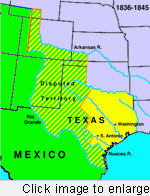About Texas Counties
History • Function • Structure • Elected Offices • Fun Facts
The History
The origin of Texas county government can be found in "municipality," the local unit of government under Spanish and Mexican rule. The municipalities were large areas embracing one or more settlements and the surrounding rural territory. In 1821, there were four major Spanish settlements in Texas—San Antonio, Bahía (Goliad), Nacogdoches, and the Rio Grande Valley—and three areas of light settlement and ranching and four major roads.
 Prior to the revolution of Texas against Mexico, there was no political subdivision at the county level. In 1835, Texas was divided into departments and municipalities. Three departments were established—Bexar, Brazos and Nacogdoches—along with 23 municipalities.
Prior to the revolution of Texas against Mexico, there was no political subdivision at the county level. In 1835, Texas was divided into departments and municipalities. Three departments were established—Bexar, Brazos and Nacogdoches—along with 23 municipalities.
Under the new Republic in 1836, the 23 municipalities became counties. When Texas became a state in 1845, there were 36 counties.
Under the state constitution of 1845, county government varied little from that under the Republic. The only major change was one that made all county offices elective positions.
When Texas entered the Confederacy in 1861 and adopted a new state constitution, there were 122 counties.
Ten years after Reconstruction from the Civil War, the Constitution of 1876 was adopted. It is the present state constitution and contains much detail concerning the governmental organization of the county. The number of counties increased steadily until there were 254 counties in 1931.
|
|

